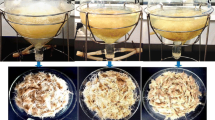Abstract
The experiments of elicitation and in situ adsorption were conducted in shake flasks and then tested in a modified bubble column bioreactor for enhancing the productions of three active metabolites in Tripterygium wilfordii Hook. f., triptolide, wilforgine and wilforine. Methyl jasmonate was screened out as the elicitor and the non-ionic polymeric ion-exchange resin of Amberlite® XAD-7 was used for in situ product removal and protecting the alkaloids from degradation in the medium. In shake flask experiments, 3.55-fold, 49.11-fold, and 10.40-fold of triptolide, wilforgine, and wilforine, respectively, could be recovered from the medium and XAD-7 resin by elicitation and in situ product removal, compared with the control. The modified 10 L bubble column bioreactor had similar productions of the three active metabolites but needed a further optimization of parameters for better growth of adventitious roots.









Similar content being viewed by others
References
Ma J, Brach AR, Liu Q (1999) A revision of the genus Tripterygium (Celastraceae). Edinb J Bot 56:33–46
Brinker AM, Ma J, Lipsky PE, Raskin I (2007) Medicinal chemistry and pharmacology of genus Tripterygium (Celastraceae). Phytochemistry 68:732–766
Luo DQ, Zhang X, Tian X, Liu JK (2004) Insecticidal compounds from Tripterygium wilfordii active against Mythimna separata. Z Naturforsch C 59:421–426
Phillips PA, Dudeja V, McCarroll JA, Borja-Cacho D, Dawra RK, Grizzle WE, Vickers SM, Saluja AK (2007) Triptolide induces pancreatic cancer cell death via inhibition of heat shock protein 70. Cancer Res 67:9407–9416
Beroza M (1952) Alkaloids from Tripterygium wilfordii Hook.: wilforgine and wilfortrine. J Am Chem Soc 74:1585–1588
Monache FD, Bettolo GBM, Bernays EA (1984) Isolation of insect antifeedant alkaloids from Maytenus rigida (Celastraceae). Zeitschrift für Angewandte Entomologie 97:406–414
Xia Z, Chen J (1990) Alkaloids from stems and leaves of Tripterygium wilfordii. Chin Pham J 25:266–267
Ramachandra Rao S, Ravishankar GA (2002) Plant cell cultures: chemical factories of secondary metabolites. Biotechnol Adv 20:101–153
Smetanska I (2008) Production of secondary metabolites using plant cell cultures. Adv Biochem Eng Biotechnol 111:187–228
Miao GP, Zhu CS, Feng JT, Han J, Song XW, Zhang X (2013) Aggregate cell suspension cultures of Tripterygium wilfordii Hook. f. for triptolide, wilforgine, and wilforine production. Plant Cell Tissue Organ Cult 112:109–116
Baque MA, Moh SH, Lee EJ, Zhong JJ, Paek KY (2012) Production of biomass and useful compounds from adventitious roots of high-value added medicinal plants using bioreactor. Biotechnol Adv 30:1255–1267
Kemin D, Yan W (1994) Determination of total alkaloids in different areas and different application parts of Tripterygium Wilfordii and T Hypoglaucun. Chin Tradit Pat Med 16:41–42
Yiming S, Jianzhong X, Zhian W, Xuping Y (2009) Determination of triptolide in different ages of root and different parts of Tripterygium wilfordii Hook f. by HPLC. Chin J Mod Appl Pharm 26:904–906
Gao M, Zhang W, Ruan C (2011) Significantly improved taxuyunnanine C production in cell suspension cultures of Taxus by process intensification of repeated elicitation, sucrose feeding, and in situ adsorption. World J Microbiol Biotechnol 27:2271–2279
Komaraiah P, Ramakrishna SV, Reddanna P, Kavi Kishor PB (2003) Enhanced production of plumbagin in immobilized cells of Plumbago rosea by elicitation and in situ adsorption. J Biotechnol 101:181–187
Yan Q, Hu Z, Tan RX, Wu J (2005) Efficient production and recovery of diterpenoid tanshinones in Salvia miltiorrhiza hairy root cultures with in situ adsorption, elicitation and semi-continuous operation. J Biotechnol 119:416–424
Pauwels L, Inze D, Goossens A (2009) Jasmonate-inducible gene: what does it mean? Trends Plant Sci 14:87–91
Vlot AC, Dempsey DA, Klessig DF (2009) Salicylic acid, a multifaceted hormone to combat disease. Annu Rev Phytopathol 47:177–206
Kwon IC, Yoo YJ, Lee JH, Hyun JO (1998) Enhancement of taxol production by in situ recovery of product. Process Biochem 33:701–707
Brinker AM, Raskin I (2005) Determination of triptolide in root extracts of Tripterygium wilfordii by solid-phase extraction and reverse-phase high-performance liquid chromatography. J Chromatogr A 1070:65–70
Aoyagi H, Kobayashi Y, Yamada K, Yokoyama M, Kusakari K, Tanaka H (2001) Efficient production of saikosaponins in Bupleurum falcatum root fragments combined with signal transducers. Appl Microbiol Biotechnol 57:482–488
Chishaki N, Horiguchi T (1997) Responses of secondary metabolism in plants to nutrient deficiency. Soil Sci Plant Nutr 43:987–991
Wink M (1994) The cell culture medium: a functional extracellular compartment of suspension-cultured cells. Plant Cell Tissue Organ Cult 38:307–319
Dos Santos RI, Schripsema J, Verpoorte R (1994) Ajmalicine metabolism in Catharanthus roseus cell cultures. Phytochemistry 35:677–681
Pitta-Alvarez SI, Spollansky TC, Giulietti AM (2000) The influence of different biotic and abiotic elicitors on the production and profile of tropane alkaloids in hairy root cultures of Brugmansia candida. Enzyme Microb Tech 26:252–258
Choi SM, Son SH, Yun SR, Kwon OW, Seon JH, Paek KY (2000) Pilot-scale culture of adventitious roots of ginseng in a bioreactor system. Plant Cell Tissue Organ Cult 62:187–193
Cui XH, Chakrabarty D, Lee EJ, Paek KY (2010) Production of adventitious roots and secondary metabolites by Hypericum perforatum L. in a bioreactor. Bioresour Technol 101:4708–4716
Huang WH, Zhang R, Si JP, Guo BL (2008) Examination the contents and qualities of 4 alkaloids in different species of Tripterygium. The fifth national academic meeting of Tripterygium, Taining
Acknowledgments
This work is supported by the National Natural Science Foundation of China (Grant No. 31272110) and the Special Fund for Agro-scientific Research in the Public Interest (No. 200903052).
Author information
Authors and Affiliations
Corresponding authors
Additional information
G. P. Miao and C. S. Zhu contributed equally to this work.
Electronic supplementary material
Below is the link to the electronic supplementary material.
Rights and permissions
About this article
Cite this article
Miao, G.P., Zhu, C.S., Yang, Y.Q. et al. Elicitation and in situ adsorption enhanced secondary metabolites production of Tripterygium wilfordii Hook. f. adventitious root fragment liquid cultures in shake flask and a modified bubble column bioreactor. Bioprocess Biosyst Eng 37, 641–650 (2014). https://doi.org/10.1007/s00449-013-1033-0
Received:
Accepted:
Published:
Issue Date:
DOI: https://doi.org/10.1007/s00449-013-1033-0




